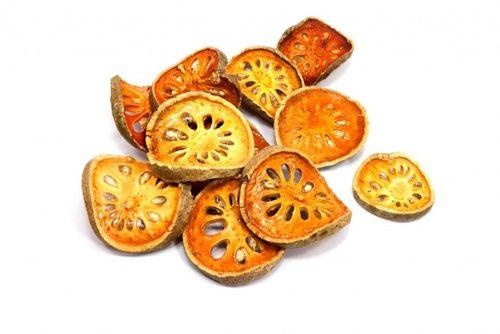Il bael, or wood apple, is the fruit of the Aegle marmelos tree. Rich in protein, fiber and vitamins, it is useful for the stomach, intestines, respiratory tract and in case of diabetes. Let's find out better.
> Calories, nutritional values and properties of Bael
> How to eat Bael

Description of the fruit
Bael, a name that probably will say almost nothing to most people, a fruit so unknown that non avere un vero e proprio nome in del paese.
Aegle marmelos, called in English stone apple or wood apple, is a tree of about twenty meters, typical of India, Sri Lanka, Pakistan, Nepal, Bangladesh, Thailand, Myanmar, Philippines, Indonesia. It is extremely resistant, capable of growing in desert or rainy environments, with climates that can range from fire temperatures over 40 ° up to several degrees below zero, and is also very tolerant with different soil pH levels.
Its fruit is a sphere with a woody exocarp, hard, green when unripe and golden yellow when ripe. Inside we find one orange pulp, with an intriguing flavor comparable to a papaya mixed with lime and with a strongly resinous aftertaste. The pulp is a thick, pasty and gelatinous cream, not homogeneous and sometimes grainy.
Bael, ally of
Stomach and intestine, respiratory tract, those who follow therapies to fight diabetes and some cancers such as papillomas.
Calories, nutritional values and properties of the bael
100 grams of bel contain about 137 calories,
- 1 mg of sodium
- 1 mg of potassium
- 32 g of carbohydrates
- 3 g of fiber
- 28 g of sugar
- 2 g of protein
The fruit it contains proteins, fats, a lot of dietary fiber, vitamins C, A and almost all those of group B, minerals such as copper, potassium, iron, calcium and phosphorus.
It can be big help for the digestive system, helping in case of constipation, diarrhea, dysentery and ulcer. With bael oil, earaches are traditionally treated.
A moderate consumption of bael reduces the acidity of the metabolism and is helpful in cases of asthma and dysuria. It's a effective antidiabetic, containing active ingredients that act in a similar way to insulin; strongly antioxidant, especially towards specific groups of tumor forms; and finally it is considered re-energizing, remineralizing, antimicrobial and antifungal.
Contraindications of Bael
Excessive consumption can be cause of gastrointestinal discomfort, such as pain and gas production. The resins contained in the fruit can be agenti allergizzanti in people predisposed to this type of discomfort and can irritate the throat and oral cavity.
Curiosity
- The bael is one of the four fruits sacred to Hindus, together with coconut, jambul and cannonball fruit, and this fruit is already mentioned in the Vedic texts.
- The bael tree is strongly aromatic and an oil is made from it among other things rich in limonene with which soaps and shampoos are flavored.
How bael is eaten
The season of availability of the fruit is from late January to early June, and during this time it is easy to find fresh baels in the countries of origin. Out of season the dried pulp is consumed.
The fruit it must be mature, therefore with reduced traces of green on the exocarp, but not excessively ripe: if there are cracks on the skin, it is best not to consume the fruit. The exocarp opens in two with the help of a tool such as a hammer, or by banging it on a hard surface.
The pulp contains about ten seeds, also edible if ground and prepared. Dried slices of bael are sometimes eaten like cookies and dipped in hot drinks. With fresh fruits it is not difficult to see jams, syrups and sweets produced.
READ MORE
The properties, benefits and contraindications of kumquat
In collaboration with Giacomo Colomba
| Naturecure.in


























